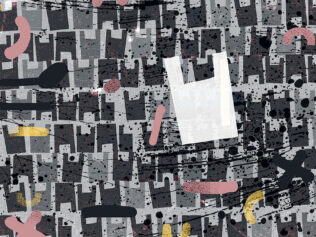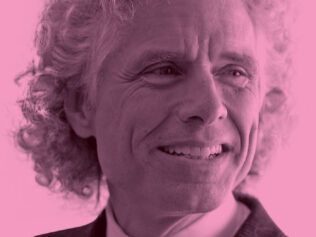
Why do we ignore what’s happening here and now, to seek out global catastrophes on the horizon? And why does that say more about us than about the condition of the universe?
It may be a luxuriously-outfitted shelter, used by the U.S. Army years ago, somewhere in rural Indiana. If you step on the accelerator hard enough, you can get there in about 24 hours from anywhere on the East Coast or in the Midwest. The solid Cold War-era construction, specially designed for a nuclear conflict, guarantees survival even in the most extreme conditions. In fact, from the outside, everything looks a bit crude, but the interior recalls quite a nice four-star hotel. Leather chairs, comfortable bedrooms, Ultra HD TVs on the walls, and a luxuriously equipped kitchen, in which – for now – the only workers are small, smiling dolls in cooks’ uniforms.
But it could also be a military base built in the 1940s in South Dakota. Of course, it doesn’t look so exclusive, but it’s made up of equally indestructible objects, which “can withstand virtually everything”. Here you have two options: a more expensive, private bunker, or a space in a common bunker. Meaning precisely: a bed and access to a small room with couches and a table. Whatever you choose, you receive a guarantee that maybe soon you’ll be surrounded only by like-minded people, as savvy as you are. In their company you certainly won’t be bored.
Meanwhile, if you live in Europe and don’t intend to move to the States, it can be your own individual 230-square-metre space, in one of the largest and best-protected underground military complexes in the world. It was built back in the previous era by far-sighted specialists from the Soviet Union. Day and night, they carefully dug out tunnels and chambers in the Thuringian Forest, a mountain range that stretches from Thuringia to Bavaria. Their efforts turned out to pay off exceptionally well, because today it’s precisely there – specifically, near the town of Rotstein – that you have the chance to guarantee yourself and your loved ones a safe harbour.
How will you get there, when the time comes? Whatever the case, you can count on professional transport – for the appropriate fee, of course. Helicopters capable of landing in the most difficult conditions, unsinkable boats or armoured cars that are equally resistant to the whims of the external environment will pick you up, from wherever you want, and bring you to the place where your advance purchased rescue awaits you.
But since you’re an exceptionally cautious person and you can’t stop thinking that at the critical moment no helicopter will come for you, the boat won’t arrive and the car won’t make it through, don’t worry, there’s yet another solution: a number of capsules that are spacious, but not excessively so; made of steel that can withstand “virtually everything either Mother Nature or mankind can throw at it”, which you can easily install in your garden at home. To live comfortably in one of these capsules, you only need a little external infrastructure: a source of water, a place to pump out waste, a fuel tank. Other than that, you’ll be 100% self-sufficient. At least for a year, because that’s how long the reserves gathered in the capsule will last.
But remember that time is flying, and every moment there’s less of it in which to decide on an option. We’re told this both by ancient prophecies and by the newest projections of climate scientists. What speaks more to your imagination: mist-enshrouded myths, or technocratic analyses provided in the form of complicated scientific calculations? An invasion from outer space, or the deplorable effects of the anger of an almighty deity, or rather an ecological cataclysm caused by a rapacious economy and the greenhouse effect?
Regardless of your personal preferences, one thing is certain.
A global catastrophe is on the way.
Any minute now.
The rich survive
This is by no means a scene from yet another Hollywood blockbuster, stuffed with special effects and skilfully playing on our various fears and obsessions. It’s an entirely real offering from the catalogue of the Vivos company, probably the largest organization devoted to selling facilities meant to guarantee their residents survival after the inevitable approaching apocalypse. Prices range from several thousand to several million dollars. And there’s no shortage of takers. That’s why the company recently expanded its operations to include the European market.
Of course, the identities of the clients are kept strictly confidential, but work by New Yorker writer Evan Osnos indicates that they’re largely recruited among Silicon Valley experts and the richest American businessmen. Isn’t it a paradox, Osnos asks in his January 2017 essay “Doomsday Prep for the Super-Rich”, that it’s precisely the people who lack nothing, and whose life is overflowing with luxury and material goods, who fantasize the most about losing it all?
Similar trends have also been noted by Douglas Rushkoff, an American sociologist and media expert. In his medium.com essay “Survival of the richest” (which, by the way, was for a time a viral hit), Rushkoff described an unusual meeting with several wealthy Americans. He was meant to deliver a lecture to them about the future of technology, but it quickly turned out that his listeners were interested in something completely different. To wit: how to survive The Event.
How can you prepare for it? How can you protect yourself against its destructive consequences? Where is it better to seek shelter: in Alaska or New Zealand? And after the global cataclysm, will money still have any value at all? And if not, how can you entice guards to continue serving their employers? Are there any disciplinary devices that can be permanently mounted on their bodies? And perhaps some special psychological techniques of influence should be used? These are among the questions that the “super-wealthy guys — yes, all men — from the upper echelon of the hedge fund world” asked themselves.
But they’re not the only ones who fear radical misfortune. Opinion research indicates that a significant percentage of members of Western societies believe a global catastrophe is coming. It’s imagined in various forms – from a climate collapse, through a mass zombie attack.
Contrary to appearances, this is by no means such an egotistical fear. According to a poll conducted last year for NOW TV, almost 25% of Brits are taking this possibility perfectly seriously. But that’s just a fragment of this apocalyptic mania, or maybe hysteria, which is simply blossoming before our eyes. On the screens of cinemas and television sets, apocalyptic and post-apocalyptic productions rule the roost. The Doomsday Clock, an indicator of the threat of nuclear holocaust developed by University of Chicago scientists, shows just two minutes to midnight, meaning that the experts think the risk of an atomic crisis is very high. The prospects of World War III seem completely real. The internet is bursting with more or less home-grown prophecies of ‘the last days’. And the market for shelters that can survive ‘practically everything’, where Vivos is doing such good business, is growing exceptionally fast.
Archetype from beginning to end
Maybe the end of the world is really coming, and all of us can feel it. But it may also be that in today’s culture a certain archetypal, ancient fantasy has become particularly active; a fundamental myth for the Western imagination.
And the thing about myths and fantasies is that they can act in an incredibly strong way on human behaviour. English historian Nicholas Goodrick-Clarke, who died prematurely after writing what is now a classic work, The Occult Roots of Nazism, wrote: “For historians trained exclusively in the evaluation of concrete events, causes, and rational purposes, this netherworld of fantasy may seem delusive. They would argue that politics and historical change are driven only by real material interests. However, fantasies can achieve a causal status once they have been institutionalized in beliefs, values, and social groups. Fantasies are also an important symptom of impending cultural changes and political action.”
So what do we learn about contemporary culture from these imaginings of an impending apocalypse that are permeating the collective consciousness? Of course, climate specialists have been warning for a long time that if current trends in exploitation of the environment aren’t slowed, the species Homo sapiens won’t be able to exist any longer on the earth. But here a whole range of attitudes is possible: from rational mobilization, with the goal of gradually solving specific existing problems, all the way through getting bogged down in apocalyptic fantasies. It seems that both on the level of mass culture and that of the convictions of the financial elite, we are dealing today with an intensification of the latter process.
But imagining the end of the world is by no means a modern invention, just an archetype – in the full meaning of that word. And thus it has been inscribed in Western culture ever since its Christian (or rather, Judeo-Christian) roots. The first Christians – as we often forget today – were broadly and rabidly convinced of the quick second coming of Christ. It was to happen while they were still alive. This peculiar eschatological atmosphere, saturated with the feeling that one was living in the last days, seeped into Christianity from the Judaism of the time. And in Judaism it arrived via Oriental mythology, particularly Persian, as well as Babylonian and Egyptian. In St. John’s Book of Revelation, the prophetic New Testament book that’s usually dated to the end of the 1st century, the phrase “the time is near” appears several times. Historians say the belief that the Second Coming will arrive any moment has been present in Christianity more or less since the middle of the 2nd century. It was only afterwards, gradually, that it changed into an expectation whose horizon is not specified. In the Western imagination, Revelation says that the end of time will be accompanied by a series of spectacular events that ends with the Final Judgment of humanity.
Mircea Eliade, the outstanding Romanian scholar of religion (and simultaneously a person with a very dark, fascist past) says that the imagination of the apocalypse, or, in any case, of a spectacular end of the world, is the price for the historicity of Western culture. In other words, of having a past and a future; of thinking in categories of a beginning and an end. Ancient societies, as well as Eastern cultures such as Hinduism and Buddhism, operated and sometimes still operate with a completely different concept of time. Rather than a Judeo-Christian linearity, with a beginning and an end, which are determined by an omnipotent deity, there we have cyclicity. In this model, the concept of an apocalypse makes no sense, because time doesn’t flow from point A to point B, but in a circle. So every end is simultaneously a beginning, every beginning is an end, and everything constantly returns and repeats, infinitely. Meanwhile, Judeo-Christian linearity, begun with the expulsion from the garden of paradise in which divine eternity prevailed, is characterized by an inexorable trending toward the culmination of history, some kind of final resolution, ending, closing.
And it’s precisely for that reason that in the Western imagination there is engraved a constant waiting for a tragic end, a feeling of an elusive threat lurking somewhere on the horizon. Sometimes (for example, in fundamentalist religions) it’s defined very precisely; at other times it’s precisely unstated, existing somewhere on the thin line between consciousness and unconsciousness.
Of course, this condition doesn’t remain without influence, not only on the politics, economics and structure of Western societies, but also on individual psychology. And also on the numerous points where these spheres connect. An example? Here’s the first one that comes to mind. Many commentators on American politics point to the fact that the 2003 American invasion of Iraq was determined to a great degree by the religious beliefs of George W. Bush and a significant portion of his electoral support, meaning those who profess the evangelical version of Christianity and have a clear inclination to read the Bible literally. Much indicates that after the attacks on the World Trade Center, they were sincerely convinced that they had to prepare for the final battle with the forces of evil. A battle that would be followed by the end of time.
The effects have included the radicalism of the War on Terror, as well as the choice of an armed overthrow of Saddam Hussein’s regime and the installation in his place of the American model of democracy. Of course, there is a whole list of alternative explanations, but returning to the earlier quote from Goodrick-Clarke, it’s also worth taking into account the motive power of the subtle world of fantasy and imagination, which is usually underestimated or ignored.
The example of the invasion of Iraq also illustrates other mechanisms typical of the apocalyptic imagination. James Hillman, an American psychologist who died in 2011, stressed that it is distinguished precisely by dualism (a conviction that in the world, or in myself, two opposing forces, most commonly good and evil, are clashing) and the need to have a clearly defined enemy, which goes hand in hand with this belief. Other attributes include binary thinking, a focus on what the future will bring rather than what’s here today, and, perhaps most importantly, constant expectation of a crisis; of a change after which nothing will be like it was before.
Total improvisation
In the book Present Shock: When Everything Happens Now, published a few years before his meeting with the Croesuses looking out for The Event, Rushkoff presented the thesis that a stronger apocalyptic tendency is a characteristic of the current era. In a world of developed digital technologies, where everything happens here and now, in this relentless, unending transmission that goes on for 24 hours a day, imagining a radical ending paradoxically brings relief, Rushkoff says. Of course, this is only superficial relief, but it has an undoubted, sometimes magnetic, charm.
But the digital reality isn’t everything. Pollution of the environment and alarming climate changes, the economic crisis and its far-reaching effects, the radical and still deepening chasm between the richest few percent and the rest of humanity, the runaway development of medical technologies allowing the perfection and modification of the human body to a degree thus far almost unimaginable – many of us believe or feel that the world in this form can’t last much longer. In this sense, the intrusively recurring imagining of the apocalypse – along with the methods and mechanisms by which we can supposedly survive it – may become a type of test that tells us more about where we are today than about what will happen tomorrow.
So let’s think: what do the kilometres of military bunkers in Indiana and South Dakota, or those dug into the German mountains near the charming city of Rotstein, tell us about our vision of community and interpersonal relationships? What do these underground lifeboats – available only for an eye-watering sum and to which a handful of the select few super-rich are to be transported by specially paid-for helicopters, amphibious vehicles or armoured cars – tell us about solidarity and the ability to overcome problems and threats? What can we learn about empathy, closeness or the feeling of brotherhood from deliberations about the ways employers can protect themselves against the wrath of their employees at a moment when the ordinary methods of social control – police, the economic system, collectively-enforced morality – stop working?
Don’t these collective fantasies – films and novels, dreams and prophecies, scientific calculations and religious revelations – allow us to identify an exceptionally strong fear that the current shape of the world, its apparently stable structure, is in fact totally improvised? That our lofty democratic ideals of equality, freedom, non-discrimination, emancipation, universal access to various goods, tolerance, protection against violence, and human rights are best implemented in theory, in soaring speeches or on paper, but they don’t have a whole lot to do with everyday practice? That sincere, or at least proper interactions between people from different social classes, between employers and workers, between rich and poor, actually mask brutal enmity, which will explode as soon as the foundations of the social order collapse?
***
As Goodrick-Clarke stresses, fantasies have the power of self-fulfilling prophecies. But only when we take them as literal truth and forget about their metaphorical dimension.
If that’s how it is, then even today we have a choice: invest all our savings in steel capsules or indestructible bunkers, wondering all the time how to avoid death at the hands of our fellow citizens, or perceive in the apocalyptic fear something in the way of a warning, and an impetus to change.
But it’s not about a radical or fundamental change whose arrival we should make specific preparations for. Rather the consciousness that around us there exist many perfectly real and concrete problems to solve. Many perfectly real choices to make. And many perfectly real people, with whom we share – and will continue to share – our fate.
Fantasizing about the apocalypse is the best way to forget this reality. And to get stuck in the seemingly soothing imagining of a great global catastrophe, which at a stroke will resolve all of our problems.
But among them the question of what to choose – a bunker in Indiana, South Dakota, Germany or maybe your own garden – is at least, in principle, the least troublesome.
Translated by Nathaniel Espino










